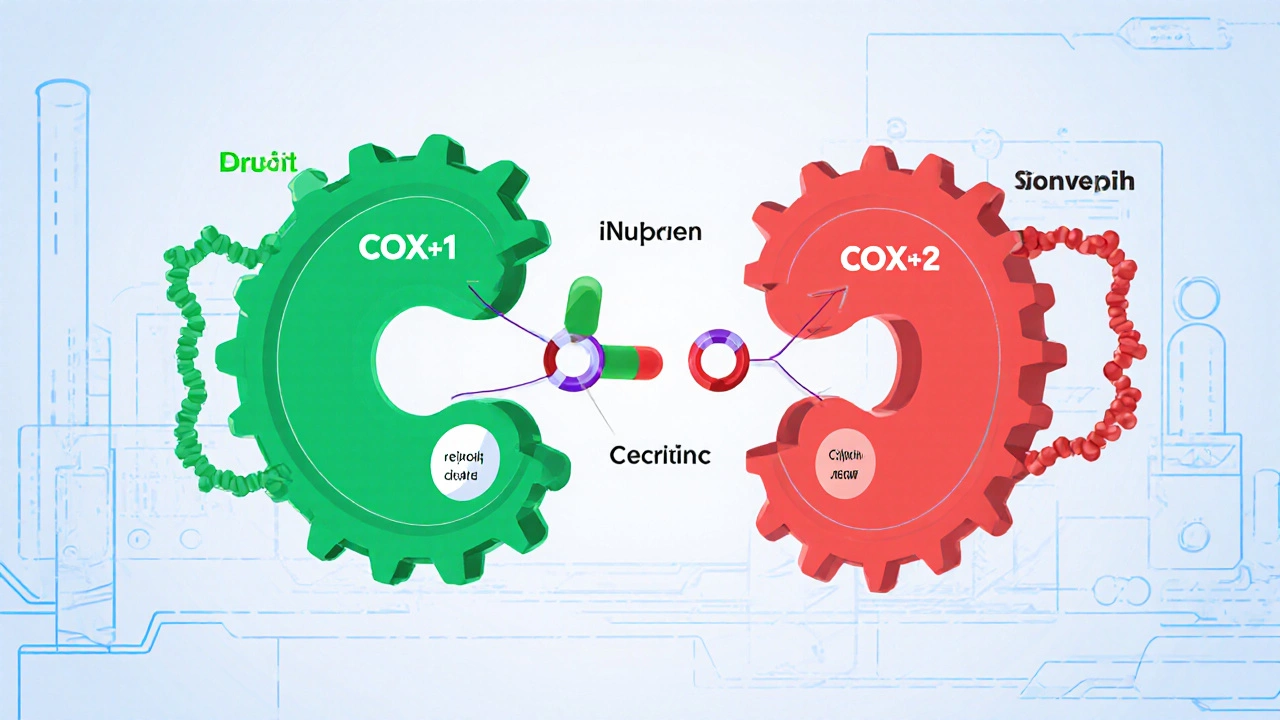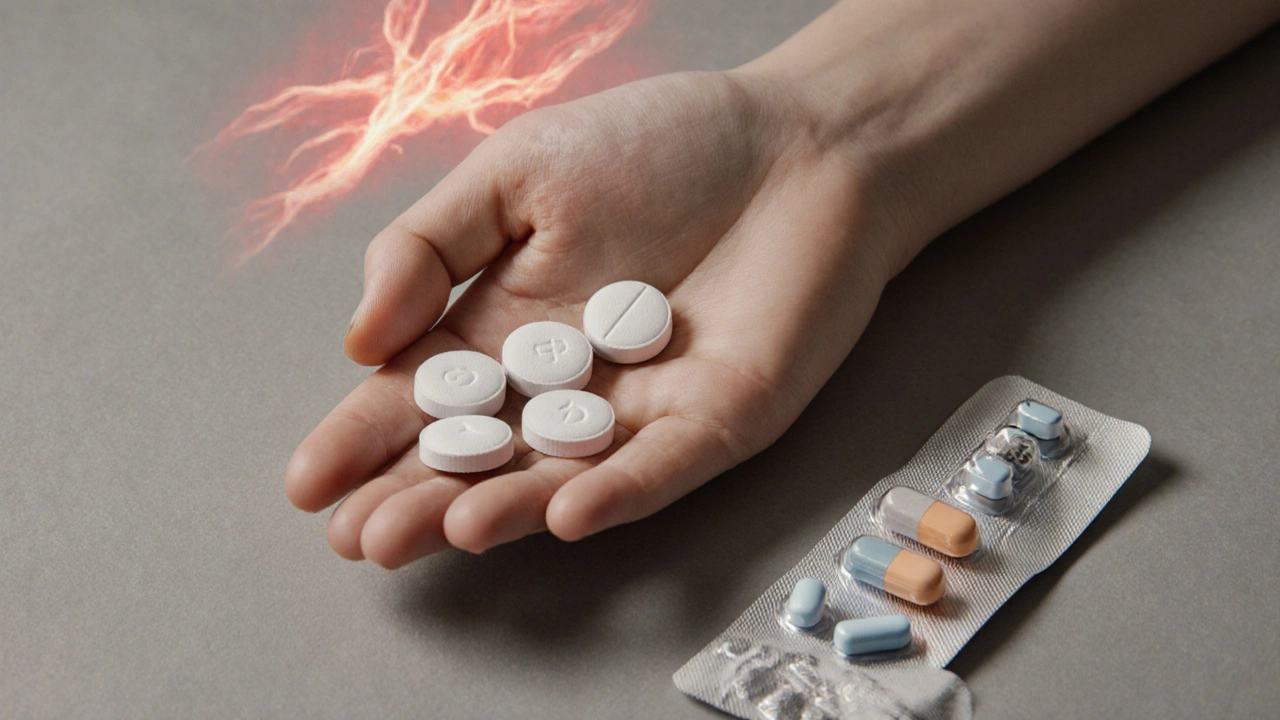Pain Medication Decision Guide
Choose Your Pain Profile
Answer a few simple questions to get a personalized recommendation for the safest and most effective pain medication.
When your muscles ache after a workout or your joints creak from arthritis, NSAIDs are non‑steroidal anti‑inflammatory drugs that reduce inflammation and block pain signals are usually the first line of defense. But the market is crowded: ibuprofen, naproxen, celecoxib, diclofenac, even acetaminophen and topical creams. How do you pick the best pain medication for muscle and joint pain without a PhD in pharmacology?
How NSAIDs Relieve Muscle and Joint Pain
NSAIDs work by inhibiting the cyclooxygenase (COX) enzymes - COX‑1 and COX‑2. These enzymes help produce prostaglandins, which are chemicals that cause inflammation, swelling, and pain. By lowering prostaglandin levels, NSAIDs calm the local inflammatory response, so you feel less ache and can move more freely.
COX‑1 is involved in protecting the stomach lining and supporting kidney function, while COX‑2 is more directly tied to pain and inflammation. Some newer NSAIDs, like celecoxib, selectively block COX‑2, aiming to spare the stomach but they bring their own cardiovascular cautions.
Top Oral NSAIDs for Muscle and Joint Pain
Below is a quick comparison of the four most commonly prescribed oral NSAIDs for orthopaedic patients. The data reflect typical adult dosing, how quickly you’ll feel relief, and the major safety flags.
| Drug | Typical Dose | Onset of Relief | Duration of Action | GI Risk | Cardiovascular Risk |
|---|---|---|---|---|---|
| Ibuprofen | 200‑400 mg every 4‑6 h (max 3200 mg/day) | 30‑60 min | 4‑6 h | Moderate | Low‑moderate |
| Naproxen | 250‑500 mg twice daily (max 1000 mg/day) | 45‑90 min | 8‑12 h | Low‑moderate | Low |
| Celecoxib | 200 mg once daily (or 100 mg twice daily) | 60‑90 min | 12‑24 h | Low | High (especially in heart disease) |
| Diclofenac | 50‑75 mg two or three times daily (max 150 mg/day) | 30‑45 min | 6‑8 h | Moderate‑high | Moderate‑high |
For most healthy adults with mild‑to‑moderate muscle soreness, ibuprofen is a solid starter because it’s inexpensive and widely available. If you need longer coverage (for chronic joint flare‑ups) without taking a pill every few hours, naproxen’s extended half‑life is handy.
Patients with a history of stomach ulcers often prefer celecoxib because it spares the gastric lining, but they must be screened for heart disease first. Diclofenac is effective for intense joint inflammation (e.g., post‑operative knee pain) yet carries higher GI and cardiovascular warnings, so it’s usually reserved for short‑term bursts.
When Acetaminophen (Paracetamol) Is the Safer Choice
Acetaminophen isn’t an NSAID - it works mainly in the brain to raise the pain‑threshold. It’s gentler on the stomach and kidneys, making it a go‑to for patients who can’t tolerate NSAIDs.
Typical adult dose: 500‑1000 mg every 4‑6 h, not exceeding 3000 mg per day (some guidelines allow 4000 mg under close monitoring). Acetaminophen shines for low‑grade muscle aches, headaches, and fever, but it does **little** for swelling because it doesn’t block prostaglandins in peripheral tissues.
Key safety note: chronic high‑dose use can damage the liver. If you drink alcohol regularly or have liver disease, keep the total daily dose well below the ceiling.

Topical Analgesics: Capsaicin, Menthol, and NSAID Gels
When you want pain relief **right where it hurts** without systemic side effects, topical agents are worth a try.
- Capsaicin (derived from chili peppers) depletes substance P, a neurotransmitter that carries pain signals. Apply 0.025‑0.075 % cream twice daily for several weeks to feel a gradual reduction in joint pain.
- Menthol or Camphor creates a cooling sensation that masks pain. These are best for acute muscle strains.
- OTC NSAID gels (e.g., diclofenac gel 1 %) deliver the anti‑inflammatory effect locally. They’re useful for tendonitis or osteoarthritis of the knee and hand.
Topicals typically take 30‑60 minutes to work and can be used alongside oral meds, but avoid applying on broken skin or near the eyes.
Weighing Risks: GI, Kidney, and Heart Concerns
Even “over‑the‑counter” pain meds can become dangerous if used incorrectly.
- Gastrointestinal (GI) irritation: NSAIDs suppress COX‑1, which protects the stomach lining. Ulcers, bleeding, or perforation can occur, especially in people over 60, smokers, or those taking steroids.
- Kidney stress: Reduced prostaglandin flow can lower kidney perfusion, leading to fluid retention or acute kidney injury. Stay well‑hydrated and avoid high‑dose NSAIDs if you have chronic kidney disease.
- Cardiovascular risk: COX‑2 selective drugs (celecoxib) and some non‑selective NSAIDs (diclofenac, ibuprofen) have been linked to heart attacks and strokes. If you have hypertension, high cholesterol, or a prior heart event, discuss alternatives with your physician.
When you’re unsure, the safest approach is a short course (3‑5 days) at the lowest effective dose, combined with food or a proton‑pump inhibitor (e.g., omeprazole) for gastric protection.
Choosing the Right Med for You: A Decision Guide
Answer these quick questions to land on the most suitable option.
- Do you have a history of stomach ulcers or bleeding? → Favor celecoxib (if heart‑healthy) or acetaminophen.
- Is heart disease a concern? → Avoid COX‑2 selective drugs and high‑dose ibuprofen; naproxen may be safer.
- Do you need long‑lasting relief for chronic arthritis? → Naproxen (twice daily) or a prescription‑strength COX‑2 inhibitor under supervision.
- Are you treating a localized injury (e.g., sprained ankle) and want to avoid systemic meds? → Try topical NSAID gel or capsaicin cream.
- Are you pregnant or nursing? → Generally stick with acetaminophen; most NSAIDs are contraindicated.
Never mix multiple NSAIDs together. If you need both an NSAID and acetaminophen for breakthrough pain, space them out (e.g., ibuprofen 400 mg + acetaminophen 500 mg) and keep a log to avoid exceeding daily limits.
Quick Checklist Before You Reach for a Pill
| Know your diagnosis (muscle strain vs. osteoarthritis) |
| Check for stomach, kidney, or heart issues |
| Pick the lowest effective dose |
| Take with food or milk unless using a topical |
| Limit use to 3‑5 days unless a doctor says otherwise |
| Watch for side‑effects: stomach pain, dark urine, shortness of breath |
| Consult an orthopaedic specialist if pain persists >2 weeks |
Frequently Asked Questions
Frequently Asked Questions
Can I take ibuprofen and acetaminophen together?
Yes, you can combine them as long as you stay within the recommended daily limits for each. Stagger the doses (e.g., ibuprofen 400 mg every 6 h and acetaminophen 500 mg every 6 h) and avoid exceeding 3200 mg of ibuprofen or 3000 mg of acetaminophen in a 24‑hour period.
Is naproxen safer for my stomach than ibuprofen?
Naproxen has a slightly lower risk of causing gastric ulcers, but the difference isn’t huge. If you have a known ulcer, a COX‑2 selective drug (celecoxib) or acetaminophen is the safer bet.
How long should I use topical NSAID gel?
Apply the gel 2‑4 times a day for up to 2 weeks. If you see no improvement after 7 days, talk to your orthopaedic doctor about oral options.
What’s the maximum safe daily dose of celecoxib?
For most adults, the ceiling is 200 mg per day for chronic arthritis. Some short‑term post‑surgical protocols may go up to 400 mg, but only under strict medical supervision.
Are there natural alternatives to NSAIDs?
Turmeric (curcumin), omega‑3 fish oil, and ginger have mild anti‑inflammatory properties. They can complement, but not replace, NSAIDs for moderate‑to‑severe pain.
